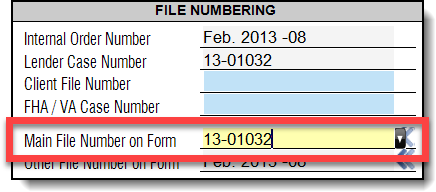Working with AI Ready reports
This document explains what "AI Ready" is, helps you to start delivering AI Ready reports with your software, and generate ENV files.
Document 2004 | Last updated: 08/15/2022 MC7
Getting Started
Creating an AI Ready Report:
To produce AI Ready appraisals, you essentially perform your appraisal process like you normally do, but you use specific, AI Ready approved forms, fill out specific information on your invoice so that it can be converted, and follow a specific workflow when working with photos and photo pages. Then, when you're ready to convert and deliver your report, you use one of the TOTAL Connect Pro plugins available with your TOTAL Connect Pro membership. TOTAL Connect Pro partners include AppraisalPort, CoreLogic Valuations, and more. Click here to learn more about a TOTAL Connect Pro membership.
When producing an AI Ready appraisal, you're really converting your report into an .ENV or Enhanced .ENV file. Enhanced .ENV files are simply .ENV files generated from a report containing one of the four UAD forms that produces a MISMO 2.6 GSE XML (click here to view which forms create a MISMO 2.6 GSE XML). Remember, if you're asked to upload an Enhanced .ENV file, simply respond that your .ENV file includes the necessary information.
Choosing forms:
For the most part, AI Ready uses all the same forms you would normally use in an appraisal report, but there are some forms specific to TOTAL that are unsupported by the AI Ready format. Our delivery plug‑in tells you at the time of delivery if a form can't be converted, but to be on the safe side, we created a group of forms in the TOTAL Contents view specifically for AI Ready forms, so you know that if you choose a form from this category, it converts properly to AI Ready.
Even if you don't plan on including a particular form in your converted file, it's a good idea to ensure that everything is legal sized to prevent other automatic forms such as location maps and sketch pages from coming in as letter size.
AI Ready Forms in TOTAL:
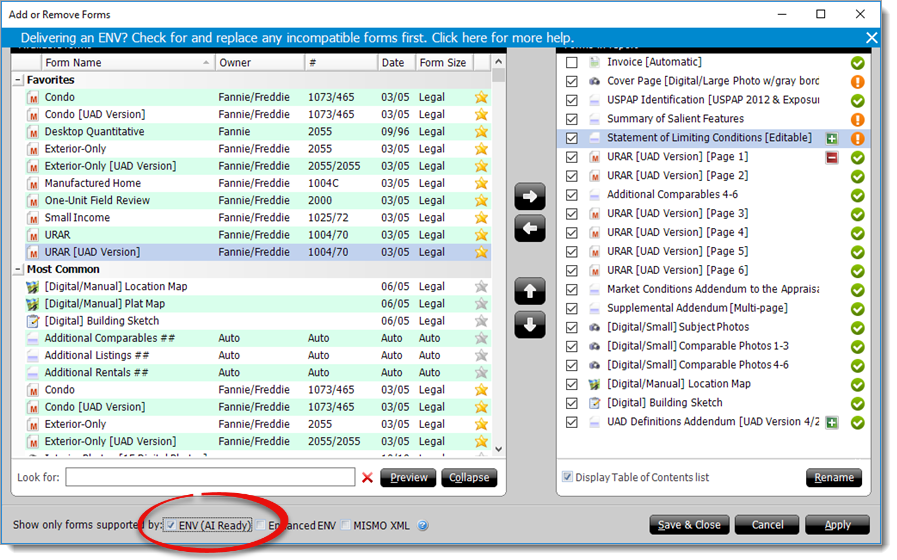
FNC limits the number of some form types sent to clients through AppraisalPort. Often it's not a problem, but keep in mind that you are limited to:
- 20 pages of text addenda — All addenda gets concatenated into a multi‑page form with a heading of "Text Addendum". Any custom headings are inserted into the body and all text formatting (fonts, bold, etc.) is removed.
- 2 plat maps
- 2 location maps
- 5 sketch pages
- 50 additional maps (all scanned and PDF addenda are shown as "maps")
- 12 comparables (3 Additional Comparable pages)
- 9 listings (3 Additional Listings pages)
We also show you at the time of conversion which forms can and can't be converted. For the ones that can't be converted you get a chance to swap them out by clicking Swap Forms in the upper right.

If you receive an error message stating "An error occurred while converting the report to an XML format. error (91) object variable or with block variable not set" when converting your report, double check that you have included a major form, indicated in the Contents by an icon with a red M on it (
), with your report.
A prime example of receiving this error message is when using the 1004D. The major form version is able to be converted to an ENV file, while the 1004D minor form isn't.
If you find that one of your addendum pages has a Conversion Status of unsupported when reviewing the pages to be delivered, it may be due to images in the addendum. AI Ready delivery doesn't support images embedded in text addenda. In order to convert the report with your images intact, move them to a photo or map page. Click the unsupported status to view additional information.

Working with photos:
Remember that AppraisalPort doesn't send the actual image pages, just the images. So, you'll want to use the standard 3 image subject and 3 image comparable photo pages. As with the forms, FNC also limits the number and type of photos to:
- 6 subject photos (front, rear, street, 3 additional)
- 12 comparable photos (Only 1 image per comparable is accepted. If you wish to include an additional photo for a comp, use a Photograph Addendum.)
- 9 listing photos
- 99 additional photos
Here are some other items to consider when it comes to photos:
- AppraisalPort supports only JPG formats for images, including your digital signature.
- For standard subject and photo pages, custom titles next to the photos and custom headings are not supported and could result in the page being omitted from the resulting AI Ready file, so just leave those as the defaults.
- Only the first line under the photo title is able to be transferred.
- While images on the miscellaneous photo pages in TOTAL labeled "Photograph Addenda" are transferred to the AI Ready file, custom text and descriptions are not transferred.
- Photos that are inserted within the text addendum will not convert to ENV.
- If you notice a particular photo page in your report not converting, try removing the photo page and then adding it back it in. This can clear up problems where the photos weren't associated with a property correctly, or if there were inadvertent customizations in the data or labels preventing conversion.
- In a report with more than 12 comps, create a pdf for comp photos 13+ and import the pdf into your report.
- The first three headings for subject photos are always labeled Subject Front, Subject Rear, and Subject Street.
PDFs imported into your reports through the Insert function in TOTAL convert to AI Ready just fine. However, their conversion process treats them as additional "map" pages, so that is how they show up regardless of the page title you enter in TOTAL.
Using a Building Sketch:
If your client says your sketch is missing, try to cut and paste the sketch back into the building sketch page in the Forms PowerView. Right‑click on the sketch image, select Cut, then right‑click again and select Paste. Keep in mind that if you scan in your sketch or insert as pdf, it shows as an additional map in the OADI viewer, no matter what you label it. Another best practice is to use the [Digital] Building Sketch page. This shows up as the sketch addendum in the OADI viewer.
Including an invoice:
While you may have an invoice in your report, only the data from it is transferred over during conversion, and it's displayed on the AI Ready invoice form. Be sure to include an invoice number and at least one line item with an amount. If you see that your invoice is showing as "unsupported", check that you are using a FNC‑compatible invoice form and that all relevant data is included.
Currently, there are 8 invoice forms compatible with FNC:
- NIV1
- NIV2
- NIV3
- NIV4
- NIV5
- NIV5 SIG
- NIV5D
- NIV6
Look for the form designation at the bottom of your invoice to verify that you're using the correct form.

Remember, do not include a logo on your invoice because it is simply converted as another miscellaneous image.
Report Delivery
Starting the delivery process:
Delivery through plugins is accomplished by using TOTAL Connect — which is installed when you install TOTAL. If you use a different formfiller, or you need to install TOTAL Connect separately, click here for instructions on downloading and installing TOTAL Connect.
When you're ready to deliver your report, make sure the report is signed and saved. Then, click Deliver to Client and hover over Deliver with TOTAL Connect.
If you're delivering your report to AppraisalPort or saving an .ENV file to upload to your client's website, select the AppraisalPort plugin. If you're delivering your report to a different client, select that client's plugin from the list. If you're delivering your report to AppraisalPort, click here for detailed delivery instructions. Otherwise, click here and choose your client from the list of plugin partners for detailed instructions.
Using FNC's Envelope Uploader / OADI Viewer:
The FNC/OADI viewer is a separate application produced by FNC. It's the tool that actually lets you view what you're about to send and upload it to the client. In some cases, you use the OADI viewer to save the .ENV file separately and upload it manually to a client's website, or deliver the .ENV file to your client via e‑mail. We recommend looking at each page generated for your appraisal before uploading.

Verify your signature was converted
To double‑check that your signature was converted by the OADI Viewer, simply open the left sidebar of the OADI Viewer, and scroll down to the bottom. There, you'll see a copy of your signature that has been included as an image file.
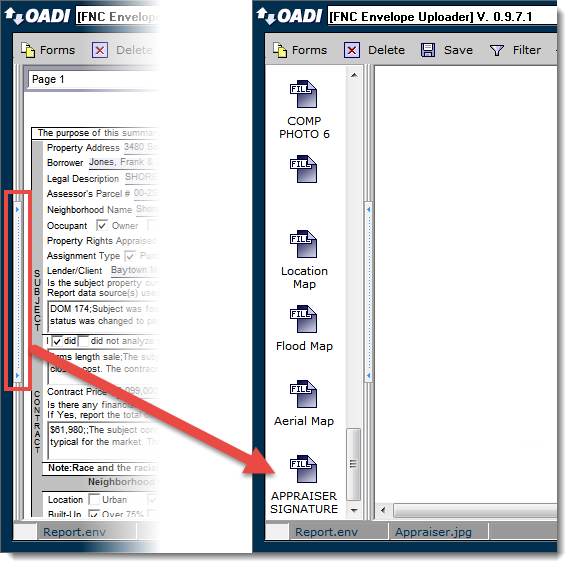
Keep in mind that AI Ready only supports JPG formats for images, including your digital signature. Additionally, AI Ready doesn't support eSign signatures and removes the serial number during the conversion process.
Username, Password and the AppraisalPort upload URL
The first time you upload a file to AppraisalPort, you're required to enter your AppraisalPort Username and Password, which is the same login information you use to log in to the AppraisalPort website. You are also required to enter the AppraisalPort Upload URL.
Click Reset URL to Default to enter the URL automatically:
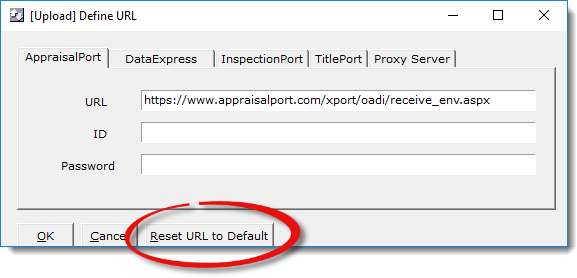
Or, enter it manually: https://www.appraisalport.com/xport/oadi/receive_env.aspx
Even though the FNC/OADI Viewer installs with our products, FNC is responsible for support once your file is in it. Please contact FNC if you need to find out your Username and Password, or for assistance with configuring the FNC/OADI Viewer. You can contact FNC directly at 888‑963‑3330.
Saving .ENV files using the OADI Viewer:
With the OADI Viewer open, click the Save button near the upper‑left of the window. You're prompted to choose a location to save the file, so be sure to choose a location you'll easily remember.
Viewing the report after it is converted to .ENV:
There are two options for viewing a report after it is converted to the .ENV format. You can use the built‑in PDF converter within the OADI Viewer if you have an AppraisalPort account, or you can use the Conversion tool on the AI Ready website, where you can browse for your file and upload it for viewing. Click here to learn more about these options.
Common questions and problems
Some of my forms are missing:
During the final step of AI Ready delivery, the OADI Viewer is intended to display the report exactly as it will be delivered. In some cases, you might not see some of your forms — such as the UAD Definitions or the Invoice. Fortunately, this is easy to fix, because the forms are already in the report that is being delivered — you just have to know how to view them.
First, the most reliable way to make sure that the delivered report appears exactly as it should is to click the PDF button in the OADI Viewer. This displays a PDF of the report as it appears after the AI Ready conversion. This is the same version of the report that your client receives.
Within the OADI Viewer, there are two ways to view the various parts of your report: the Forms button, and the Page drop‑down menu.
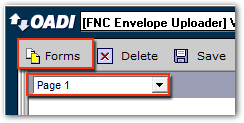
- Click Forms to view the separate forms in your report, including the major form, invoices, and certain addenda.
- Once you've selected the form you want to view, use the Page drop‑down menu to select the report pages you want to see. The OADI Viewer displays one page at a time, so instead of simply scrolling through the entire report as you might expect, you'll need to select the page you want to view using the Page drop‑down menu — then you can scroll down the page you selected to view.
My invoice didn't convert:
If you tried using the Forms button in the OADI Viewer to view your invoice, but find it isn't there, the most likely causes are that either you used an unsupported invoice or there's a lack of required information on the invoice in your report. There are eight invoice forms that are compatible with FNC:
- NIV1
- NIV2
- NIV3
- NIV4
- NIV5
- NIV5 SIG
- NIV5D
- NIV6
Additionally, your invoice must contain an Invoice number and one line item with an amount.
If you aren't using one of those invoices or your invoice doesn't include that info, it won't be included when the report is converted to AI Ready format. To fix this problem, exit the OADI Viewer, cancel the delivery wizard, and return to your report to make sure you are using the correct invoice and that the minimum information is included on the invoice. Once you're using the right invoice and you've entered the required information, start the delivery process again just as you did before.
Open the contents panel and check the box at the bottom left that says ENV (AI Ready). Then choose from this list the invoice you want to include. As always you can click preview to see what that form looks like.
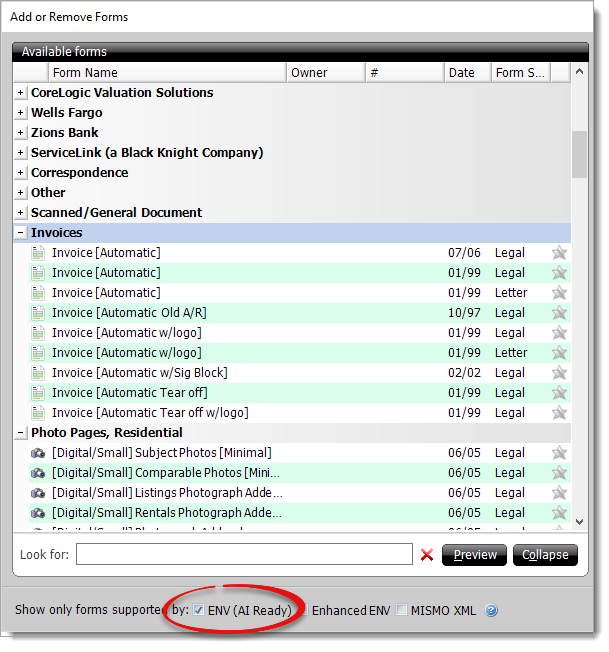
Alternatively, you can also create a new AI Ready invoice from scratch by clicking the Invoice button at the top of the OADI Viewer and selecting New.
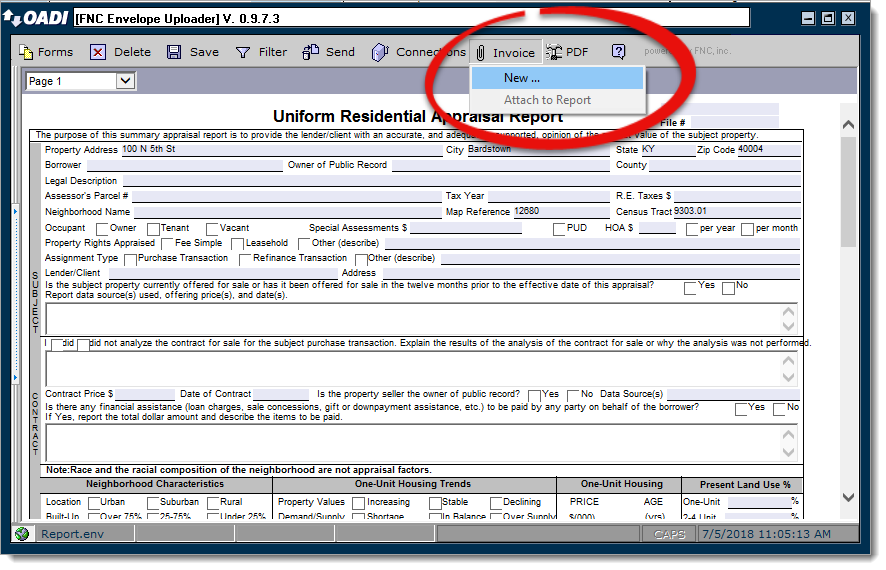
Images are missing or display a red X:
When viewing the photo pages in your report, you might see a red X indicating that the photo is missing. In the majority of cases, the photo is actually there, but you can't see it because the OADI Viewer relies on your PC's Internet cache to display them.
The root of the problem varies, but the solutions is often the same: clear your temporary Internet files. Click here for complete instructions.
Photo pages look different or have shrunk:
Remember that the AI Ready format doesn't send the actual image pages, just the images. Use the standard 3‑image subject and 3‑image comparable photo pages. As with the forms, FNC also limits the number and type of photos to:
- 6 subject photos (front, rear, street, 3 additional)
- 99 additional photos
- 9 listing photos
- 12 comparable photos
Only one image per comparable is accepted. If you wish to include an additional photo for a comp, use a Photograph Addendum.
On some systems, the first time you view a scanned page or a location map, it might appear to be about 1/4 the size of the page. This is a problem with the OADI viewer interacting with your video driver. The image is actually okay. If you resize the OADI viewer window or maximize the window, the image displays correctly.
If your image pages are missing image labels, switch the image page you're using for a Photograph Addendum.
Handling errors indicating there's no location map:
This error occurs if you change the title of the location map page to something other than Location Map. If the name of the location map page is changed, the plug‑in can't tell what type of map the page contains, resulting in the error. To resolve the issue, cancel the delivery wizard, rename the location map page to Location Map, and then deliver the report again.
Text appears cut off or missing in certain fields:
If you have reduced the font size of your commentary in order to accommodate a large amount of text, you may find that some of this text appears to be cut off or missing when viewed in the OADI Viewer, or in a PDF converted from an ENV. This is due to an issue with the AppraisalPort plugin where all text formatting is discarded by the ENV format. To avoid this, we recommend using only the default font and overflow settings when working on a report that you're delivering in AI Ready(ENV) format.
Numbered lines don't display in the addenda:
While you can choose to display line numbering in your addenda in TOTAL, as well as printed and PDF reports, this isn't a feature that appears in your report when delivering it in AI Ready format. Since the AI Ready format doesn't consider line numbers as part of the "data" in your report, they aren't included when your report is reconstructed and converted to an ENV file.
My additional comparables page did not convert:
AppraisalPort allows you to have up to three additional comparable forms in your report when you're using a common form like the 1004 or 2055. However, AppraisalPort doesn't allow you to add any additional comparable forms when using certain forms, like the Residential Valuation Services (RVS) Desktop Appraisal. If you're using a form such as this, you'll need to print the additional comparable form separately to PDF, and then insert it into your report as a photograph addendum.
Getting an error delivering to CoreLogic Valuation Services:
In rare instances, an error is displayed when delivering a report to CoreLogic Valuation Services that states The plugin was unable to connect to the remote server, or an error that states There was no endpoint listening. These errors occur when the combined file size of the ENV, XML, and PDF exceeds 20 megabytes. To correct this issue, you'll need to reduce the file size of your report. Click here for instructions on using the Image Optimizer to reduce the size of your report.
I have an unsupported form I need to send:
If you're having trouble with an unsupported form that your client insists must be in your report, a workaround is to print the unsupported form to PDF, and then insert the resultant PDF into the report. The AppraisalPort plugin converts the PDF you inserted into an image format and allows you to proceed with the delivery. Click here for instructions on inserting a PDF into your report.
Keep in mind that this workaround may not satisfy lender requirements. We recommend swapping forms to an equivalent, supported version before resorting to this workaround.
Wrong file number appears in OADI Viewer:
While TOTAL allows you to have different file numbers on each of your forms, the AI Ready conversion process uses the Main File Number on Form field from the Assignment PowerView — regardless of what you enter in the Forms PowerView.
If the wrong file number is displayed after the conversion process, close the OADI viewer, make sure you enter it exactly as you want it to appear in the Main File Number on Form field in the Assignment PowerView, and then go through the conversion process again.
